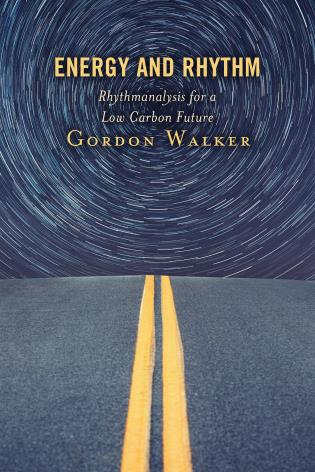This website supports the book ‘Energy and Rhythm: Rhythmanalysis for a Low Carbon Future‘ published by Rowman and Littlefield in April 2021 (for publisher discount code see April 2021 post). It also provides other resources for engaging rhythmanalysis with environment, energy, climate and related topics .
 “Rhythms animate our lives and the worlds we inhabit. Rhythms of getting things done, of working technologies, of day and night and the seasons, and of shared patterns of work, home-life and moving around. Rhythms are also intrinsically about flows of energy – heat, light, motion – from the smallest movements of muscles, to the petrol-fuelled rhythms of the rush hour, the spinning of wind turbines and shifting cycles of solar radiation. This book sets out to energise Lefebvre’s rhythmanalysis in order to develop a novel and far reaching polyrhythmic conceptualisation of the beats and pulses of our relations with energy in both its natural and technological forms. Social theory, thermodynamic thinking and diverse streams of energy-oriented research are brought together to trace how the climate crisis has the rhythmic patterning of big power energy systems at its core; and how transitioning to a just, low carbon future means transforming energy systems and our everyday dependencies on them into new rhythmic patterns and interrelations“
“Rhythms animate our lives and the worlds we inhabit. Rhythms of getting things done, of working technologies, of day and night and the seasons, and of shared patterns of work, home-life and moving around. Rhythms are also intrinsically about flows of energy – heat, light, motion – from the smallest movements of muscles, to the petrol-fuelled rhythms of the rush hour, the spinning of wind turbines and shifting cycles of solar radiation. This book sets out to energise Lefebvre’s rhythmanalysis in order to develop a novel and far reaching polyrhythmic conceptualisation of the beats and pulses of our relations with energy in both its natural and technological forms. Social theory, thermodynamic thinking and diverse streams of energy-oriented research are brought together to trace how the climate crisis has the rhythmic patterning of big power energy systems at its core; and how transitioning to a just, low carbon future means transforming energy systems and our everyday dependencies on them into new rhythmic patterns and interrelations“
There is much written about energy, carbon and climate. In this book I attempt to contribute something a bit different, making the case for bringing energy and rhythm thinking together. I argue through seven chapters, that rhythmanalysis, if worked with in a flexible way drawing on a diversity of forms of knowledge from sciences and social sciences, along with different modes of writing, has something distinctive and significant to add to the study of energy in the context of climate change and low carbon transition. A rhythmanalytic view makes clear that time and temporalities matter to stripping carbon out of energy systems and out of ways of living with energy. Not just in the sense of timescales of transition and speeds of change, but also in the very substance of how energy systems work and how they are integral to the ongoing structure and order of societies. This means that it is rhythms in transition that matter to low carbon futures, not just the temporalities and rhythms of transition. Rhythms transitioning both within and beyond energy system boundaries, rhythms in energy resources, in working technologies, in everyday activity, in infrastructures, homes, bodies and cities, in energy supply and in energy demand. Rhythmanalysis provides a framework for an integrative analysis across wildly different rhythmic phenomena, and, in this book, for applying this to understanding how rhythms and their energies interact, combine, synchronize, beat together and evolve. This all adds up to a novel, constantly dynamic way of seeing and unpacking the challenges of decarbonisation and de-energisation, in response to the urgent and potentially existential threat of climatic change
How the book begins:
The turbine cycles. The train moves. The modem flashes. The lift rises. The tide surges. The wheel rotates. The light flares. The sun rises. The chest falls. The blood pulses. The leaf opens. The fire burns. The sky darkens. The room warms. The storm rages. The waters rise. The wind blows. The klaxon sounds. The day begins. The meal finishes. The lights dim. The boiler switches. The car roars. The cold freezes. The turbine cycles.
All energy. All rhythm.
Gordon Walker is Professor at the Lancaster Environment Centre, Lancaster University